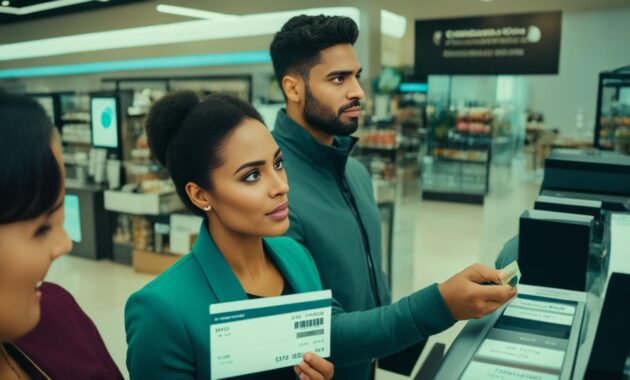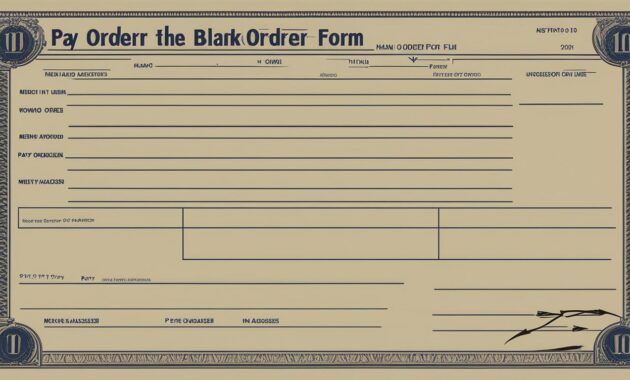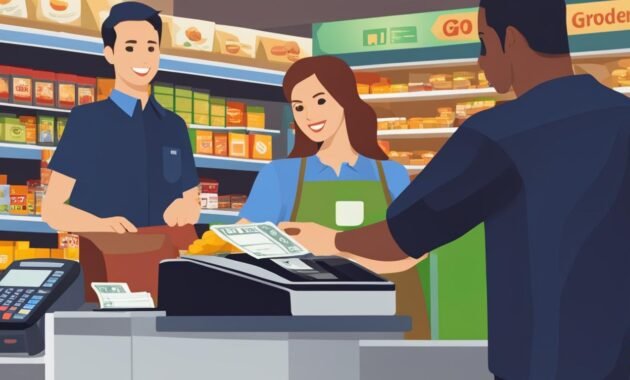Money orders are a convenient way to make secure payments, especially when cash or personal checks are not suitable options. But can you buy a money order with a credit card? The answer is yes, but it may not be in your best interest to do so. Let’s explore why.
While it’s not possible to directly purchase a money order with a credit card, you can obtain a cash advance from your credit card, which can be used to buy a money order. However, there are some drawbacks to consider. Cash advances often come with high fees and interest rates, making this method of purchasing a money order an expensive choice.
If you find yourself in a situation where cash is not readily available, it’s important to weigh the pros and cons of using a credit card for a money order. Consider the alternatives and evaluate the costs involved to make an informed decision.
Key Takeaways: Can You Buy A Money Order With A Credit Card?
- While you can buy a money order with a credit card through a cash advance, it may not be the most cost-effective option due to high fees and interest rates.
- Money orders can be a secure and guaranteed form of payment, but it’s essential to consider the potential risks and costs involved.
- Exploring alternatives like paying by credit card directly, using personal loans, or requesting salary advances can be more financially advantageous.
- Ensure you compare the costs and benefits of each alternative before deciding to use a credit card for a money order.
- Protect yourself from money order scams by verifying funds, checking for signs of forgery or tampering, and being cautious of unknown individuals or pressure tactics.
Pros and Cons of Using a Credit Card for a Money Order
When it comes to purchasing a money order, using a credit card can offer some advantages and disadvantages. It’s important to carefully consider the pros and cons before deciding whether it is the right option for you.
Pros:
- Guaranteed Payment: Using a credit card for a money order ensures that your payment is guaranteed. Unlike personal checks, money orders require payment upfront, so there’s no risk of bouncing.
- Secure Payment Method: A credit card offers a secure form of payment when sending funds through a money order. It provides an added layer of protection against potential fraud or unauthorized transactions.
Cons:
- Need for Cash Advance: Buying a money order with a credit card isn’t a direct option. Instead, you would need to obtain a cash advance, which can be expensive and come with high fees and interest rates.
Before using a credit card for a money order, it’s crucial to weigh the pros and cons and consider alternative payment methods that may be more cost-effective and convenient.
| Pros | Cons |
|---|---|
| Guaranteed payment | Need for cash advance |
| Secure payment method |
How to Use a Money Order
A money order is a convenient and secure payment method that can be used for various purposes. Whether you need to make a payment, pay bills, send money to loved ones, or even make online purchases with select retailers, a money order is a reliable option. Here’s a step-by-step guide on how to use a money order effectively.
Purchasing a Money Order
1. Find a reputable provider: Look for authorized money order issuers such as banks, post offices, grocery stores, or convenience stores.
2. Complete the purchase form: Provide the necessary details, including the recipient’s name, your name, and the amount you wish to send. Some providers may require additional information, like your address or phone number.
3. Pay for the money order: Submit the payment for the money order, usually in cash or using a debit card. Some providers may accept credit cards, but keep in mind the associated fees.
4. Keep the receipt: Hold onto the receipt until the money order is cashed or deposited. It serves as proof of purchase and contains important tracking information.
Filling Out a Money Order
1. Write the recipient’s name: Clearly and accurately write the name of the person or organization who will receive the funds. Double-check the spelling to ensure it reaches the right recipient.
2. Fill in your information: Include your name and address in the designated fields on the money order. This helps the recipient identify the sender.
3. Sign the money order: Sign your name in the designated space provided on the money order. Remember to use your legal signature for authenticity.
Once you’ve completed these steps, your money order is ready to be sent or used as a payment method. It’s important to note that money orders typically have a maximum limit, which varies depending on the issuer.
| Benefits of Using a Money Order | Considerations |
|---|---|
|
|
Cashing or Depositing a Money Order
To cash or deposit a money order, follow these steps:
1. Locate a financial institution or authorized provider that accepts money orders.
2. Endorse the money order: Flip the money order over and sign your name on the designated line on the back. This endorsement is necessary for the institution to process the funds.
3. Present identification: Show a valid photo ID, such as a driver’s license or passport, to verify your identity.
4. Receive your funds: Depending on your preference, you can either receive cash or have the money order amount deposited directly into your bank account.
“Money orders provide a secure and reliable way to send or receive funds. Whether you’re making a payment or need to send money to someone, money orders offer peace of mind with their guaranteed funds and limited personal information.”
Where to Buy a Money Order with a Credit Card

When it comes to buying a money order with a credit card, there are limited options available. Currently, no providers accept credit cards as a direct form of payment for money orders. However, there is a workaround that allows you to use a credit card to obtain the funds needed to purchase a money order.
To buy a money order with a credit card, you can opt for a cash advance. In order to do this, you can visit an ATM or use a convenience check tied to your credit card account. By obtaining a cash advance, you will have the funds necessary to buy a money order.
It’s important to note that using a credit card for a cash advance comes with some drawbacks. Cash advances usually have additional fees and higher interest rates compared to regular credit card purchases. Before deciding to go this route, it’s advisable to explore other payment options that may be more cost-effective.
While it is possible to buy a money order with a credit card, it’s important to consider the associated costs and fees. Cash advances can quickly add up and may not be the most financially responsible option. As such, it’s recommended to exhaust other alternatives before resorting to using a credit card for a money order.
Costs of Buying a Money Order with a Credit Card

Buying a money order with a credit card can come with significant costs. In addition to the money order fee, which varies depending on the provider and can range from $2.40 to $49.65, there are additional expenses associated with using a credit card for a money order.
One of the main costs is the cash advance fee. When obtaining a cash advance from your credit card to purchase a money order, you can expect to pay a fee based on a percentage of the transaction amount, typically ranging from 5%. There is also usually a minimum fee, which can be around $5 to $10, regardless of the transaction amount.
Furthermore, cash advances often have higher Annual Percentage Rates (APRs) compared to regular credit card purchases. This means that interest starts accruing immediately after the cash advance transaction, without a grace period. The interest rates for cash advances can be significantly higher than the standard purchase APR, ranging from 20% to 30% or more.
It’s important to note that these additional costs can quickly add up, making buying a money order with a credit card an expensive option.
“Buying a money order with a credit card can result in substantial costs due to the money order fee, cash advance fees, and higher interest rates for cash advances.”
| Costs of Buying a Money Order with a Credit Card | Amount |
|---|---|
| Money Order Fee | $2.40 to $49.65 |
| Cash Advance Fee | 5% of the transaction amount (minimum fee of $5 to $10) |
| Cash Advance APR | Often higher than standard APR, ranging from 20% to 30% or more |
As demonstrated in the table above, the costs of buying a money order with a credit card can vary significantly depending on the money order fee, cash advance fees, and the interest rates incurred. It’s crucial to weigh these costs against the convenience and benefits of using a credit card for a money order.
Alternatives to Using a Credit Card for a Money Order

If you need to make a payment or send money and don’t have cash on hand, there are several alternatives to consider before using a credit card for a money order. These alternatives provide different options for secure and convenient transactions. Here are some viable alternatives:
1. Paying by Credit Card Directly
If the recipient accepts credit card payments, this can be a straightforward alternative to buying a money order. Paying directly with a credit card may offer convenience and the ability to track transactions easily. However, be aware of any associated transaction fees or potential interest charges.
2. Getting a Personal Loan
Another option is to apply for a personal loan. Personal loans often offer lower interest rates compared to cash advances from credit cards. By obtaining a personal loan, you can cover your payment needs without relying on a credit card and avoid the high fees associated with cash advances.
3. Requesting a Salary Advance
If you need immediate funds, consider speaking with your employer about the possibility of a salary advance. Many companies offer salary advance programs where you can receive a portion of your upcoming paycheck before payday. This can be a convenient and interest-free option, depending on your employer’s policies.
4. Exploring Peer-to-Peer Money Transfer Apps
Peer-to-peer money transfer apps, such as Venmo, PayPal, or Zelle, offer quick and easy ways to send money to friends, family, or businesses. These platforms often allow transfers directly from your bank account or credit card. However, keep in mind any transaction fees or limitations on the amount you can transfer.
“Before using a credit card for a money order, consider alternatives such as paying directly with a credit card, getting a personal loan, requesting a salary advance, or using peer-to-peer money transfer apps. Each alternative has its own advantages and considerations.”
It’s important to compare the costs, benefits, and limitations of each alternative before making a decision. Assess your personal financial situation and choose the option that best suits your needs and preferences.
| Alternative | Advantages | Considerations |
|---|---|---|
| Paying by Credit Card Directly | – Convenience – Easy tracking – Potential rewards |
– Transaction fees – Potential interest charges |
| Getting a Personal Loan | – Lower interest rates – Fixed repayment terms – No credit card involvement |
– Application process – Creditworthiness assessment |
| Requesting a Salary Advance | – Interest-free – Familiarity with employer – No credit impact |
– Employer policies – Limited amount available |
| Exploring Peer-to-Peer Money Transfer Apps | – Quick and easy – Convenient – Wide acceptance |
– Transaction fees – Transfer limits |
By exploring these alternatives, you can find a solution that aligns with your financial goals and minimizes unnecessary costs. Remember to evaluate the pros and cons of each option and choose wisely based on your unique circumstances.
How to Fill Out a Money Order

Filling out a money order is a simple process that requires attention to detail. By following these steps, you can ensure that your money order is correctly filled out and ready for use.
Step 1: Write the Recipient’s Name and Address
Start by writing the name of the person or organization you are sending the money order to on the “Pay to the Order Of” line. Make sure to write the full name as it appears on their identification. Then, write the recipient’s complete address on the next line.
Step 2: Double-Check Spelling
Before proceeding, carefully review the recipient’s name and address for any errors or misspellings. Even minor mistakes can cause issues, so take your time to ensure accuracy.
Step 3: Sign the Money Order
On the “Purchaser,” “Signature,” or “From” line, sign your name to authorize the money order. Make sure your signature matches the name you provided when purchasing the money order.
Step 4: Keep the Receipt
After filling out the money order, be sure to retain the receipt. The receipt serves as proof of purchase and contains important information that may be needed in case you need to cancel or track the money order.
If you need further assistance or have any questions, don’t hesitate to contact the issuer of the money order or the place where you purchased it.
| Common Mistakes when Filling Out a Money Order | How to Avoid Them |
|---|---|
| Misspelled recipient’s name | Double-check the name spelling and compare it to the recipient’s identification. |
| Incomplete or incorrect recipient’s address | Ensure the recipient’s address is complete and accurate. |
| Illegible or missing signature | Take your time to sign the money order clearly and ensure that it matches the purchaser’s name. |
| Not retaining the receipt | Keep the receipt in a safe place to provide proof of purchase and track or cancel the money order if necessary. |
How to Cash a Money Order

When you have a money order in hand, you’ll need to cash it in order to access the funds. Cashing a money order is a simple process, similar to cashing or depositing a check.
To cash a money order, you have several options:
- Take it to a bank
- Visit a credit union
- Go to a check cashing store
- Visit a location of the organization that issued the money order
Regardless of the option you choose, you will need to present proper identification, such as a driver’s license, passport, or state ID. This is to ensure that you are the rightful recipient of the funds.
Once your identification is verified, you will need to sign the back of the money order. This endorsement is important as it confirms that you are the intended recipient and gives you authorization to cash the money order.
Keep in mind that there may be fees associated with cashing a money order, depending on where you go and the policies of the institution. It’s always a good idea to inquire about any applicable fees before proceeding with the transaction.
Now that you know how to cash a money order, you can confidently receive the funds and use them as needed. Whether you’re paying bills, making a purchase, or sending money to a friend or family member, money orders offer a secure and reliable method of payment.
Comparison of Money Order Cashier Providers
| Provider | Bank | Credit Union | Check Cashing Store | Organization Location |
|---|---|---|---|---|
| Identification Required | Yes | Yes | Yes | Yes |
| Fees | Vary by bank | Vary by credit union | Vary by store | Vary by organization |
| Availability | Most banks | Some credit unions | Specific stores | Organization outlets |
| Speed | Depends on bank’s processing time | Depends on credit union’s processing time | Instant, in most cases | Depends on location and staff availability |
Tips to Avoid Money Order Scams

Money order scams are a prevalent form of fraud that can leave victims out of pocket and susceptible to identity theft. To protect yourself and your hard-earned money, it’s crucial to be aware of common scams and take preventive measures. Here are some essential tips to avoid money order scams:
- Verify Funds: Before cashing a money order, ensure its authenticity by contacting the issuing organization or bank. This step helps confirm that the money order is not counterfeit or fraudulent.
- Identify Signs of Forgery or Tampering: Examine the money order carefully for any irregularities, such as misspellings, incorrect fonts, or alterations. Pay attention to the watermark, security features, and overall quality of the document.
- Avoid Unknown Individuals: Be cautious when dealing with individuals you don’t know or trust, especially if they insist on using money orders as the sole form of payment. Scammers often prefer money orders as they are difficult to trace.
- Beware of Pressure Tactics: Scammers may try to pressure you into acting quickly, putting you in a vulnerable position. Take your time, do your research, and make informed decisions.
- Stay Alert for Online Shopping Scams: When making online purchases, be wary of sellers who demand payment through money orders only. Legitimate merchants typically offer multiple payment options, including credit cards, PayPal, or other secure platforms.
- Be Skeptical of Bogus Buyers: If someone contacts you to purchase an item or service using a money order and insists on overpaying or requests a refund, it’s likely a scam. Avoid any transaction that seems suspicious or too good to be true.
- Protect Your Personal Information: Be cautious about sharing personal information like your address or bank details. Scammers can use these details to forge money orders or commit identity theft.
- Report Scams: If you believe you have encountered a money order scam or have been scammed, report the incident to your local law enforcement agency and your state’s attorney general office. You can also file a complaint with the Federal Trade Commission (FTC) or the Internet Crime Complaint Center (IC3).
Remember, being proactive and informed is the key to avoiding money order scams. Stay vigilant and protect yourself by following these tips.
Money Order Scam Example:
“Hello, I want to purchase your item, but I can only pay with a money order. Can you please provide me with your address so I can send you the payment immediately?”
– Scammer posing as a buyer
By recognizing red flags and using caution, you can safeguard your finances and prevent falling victim to money order scams.
Also Read : Best Travel Credit Cards For Beginners Guide
Conclusion
In conclusion, although it is technically possible to buy a money order with a credit card through a cash advance, it is generally not recommended due to the high fees and interest rates associated with cash advances. It’s important to consider the costs and potential risks before deciding to use a credit card for a money order.
Instead, it is advisable to explore other payment alternatives. For example, paying by credit card directly if the option is available can be a more convenient and cost-effective option. Additionally, considering personal loans or requesting salary advances can provide alternative funding sources with lower interest rates.
Money orders can be a secure and guaranteed form of payment, offering added security when sending funds. However, it’s crucial to weigh the benefits against the potential expenses associated with using a credit card for a money order. By considering other payment options and carefully evaluating the costs and risks, you can make an informed decision that meets your financial needs.
FAQs
Q: Can you purchase a money order using a credit card?
A: Yes, many places that sell money orders accept credit cards as a form of payment for purchasing it.
Q: Are there any alternatives to using a credit card to buy a money order?
A: Apart from using a credit card to buy a money order, you can also use cash, a debit card, or even a line of credit to purchase one.
Q: Will using a credit card to buy a money order affect my credit score?
A: No, using your credit card to buy a money order will not directly affect your credit score. However, it may affect your credit utilization ratio if the amount is significant relative to your credit limit.
Q: Do all places that sell money orders accept credit cards for payment?
A: No, not all places that offer money orders accept credit cards as a form of payment. It’s best to check with the specific location before attempting to use your credit card.
Q: Is using a credit card to purchase a money order a good idea?
A: It depends on the individual’s financial situation. Using a credit card may enable you to earn rewards or manage cash flow, but it’s crucial to consider any associated fees and interest charges.
Q: Can you use your credit card issuer to purchase a money order?
A: Depending on your credit card issuer, you may be able to use your credit card to buy a money order. However, it’s essential to check with your specific card issuer for their terms and policies.
Q: Can I use a credit card to pay for a money order at a Western Union location?
A: Yes, at many Western Union locations, you can use a credit card to pay for a money order.
Q: Will using a credit card to buy a money order hurt my credit score?
A: As long as you manage your credit card payments responsibly, using a credit card to purchase a money order should not negatively impact your credit score.
Q: Can I buy multiple money orders with a credit card?
A: In most cases, you can purchase multiple money orders using a credit card, as long as the location allows credit card payments for money orders.
Q: Do credit card companies accept credit cards for the purchase of money orders?
A: Yes, many credit card companies allow the use of credit cards to buy money orders. However, it’s essential to check with your specific credit card issuer for any restrictions or fees.
Source Links
- https://www.experian.com/blogs/ask-experian/can-you-buy-a-money-order-with-a-credit-card/
- https://www.bankrate.com/finance/credit-cards/how-to-buy-money-order-with-credit-card/
- https://money.usnews.com/credit-cards/articles/can-you-buy-a-money-order-with-a-credit-card